ITC571 Project Report: Emerging Tech and Storage Computation Tradeoffs
VerifiedAdded on 2023/06/03
|14
|3130
|169
Project
AI Summary
This project report delves into the concept of trading storage for computation, an emerging technology that optimizes data storage and computation efficiency. The report begins with an executive summary and table of contents, followed by an introduction to the research domain and the specific research questions addressed. A comprehensive literature review examines existing research on the topic, including the integration of cloud computing and its benefits in mitigating the challenges of traditional programming paradigms. The discussion and analysis section explores the advantages and limitations of storage trading, highlighting its application in various operational sectors. The findings section details the effectiveness of combining storage trading with cloud computing, showcasing its impact on cost reduction and increased efficiency. The report concludes with a summary of the project's key insights and references supporting the analysis. The project utilizes a student's work on the assignment provided, and can be found on the website Desklib.
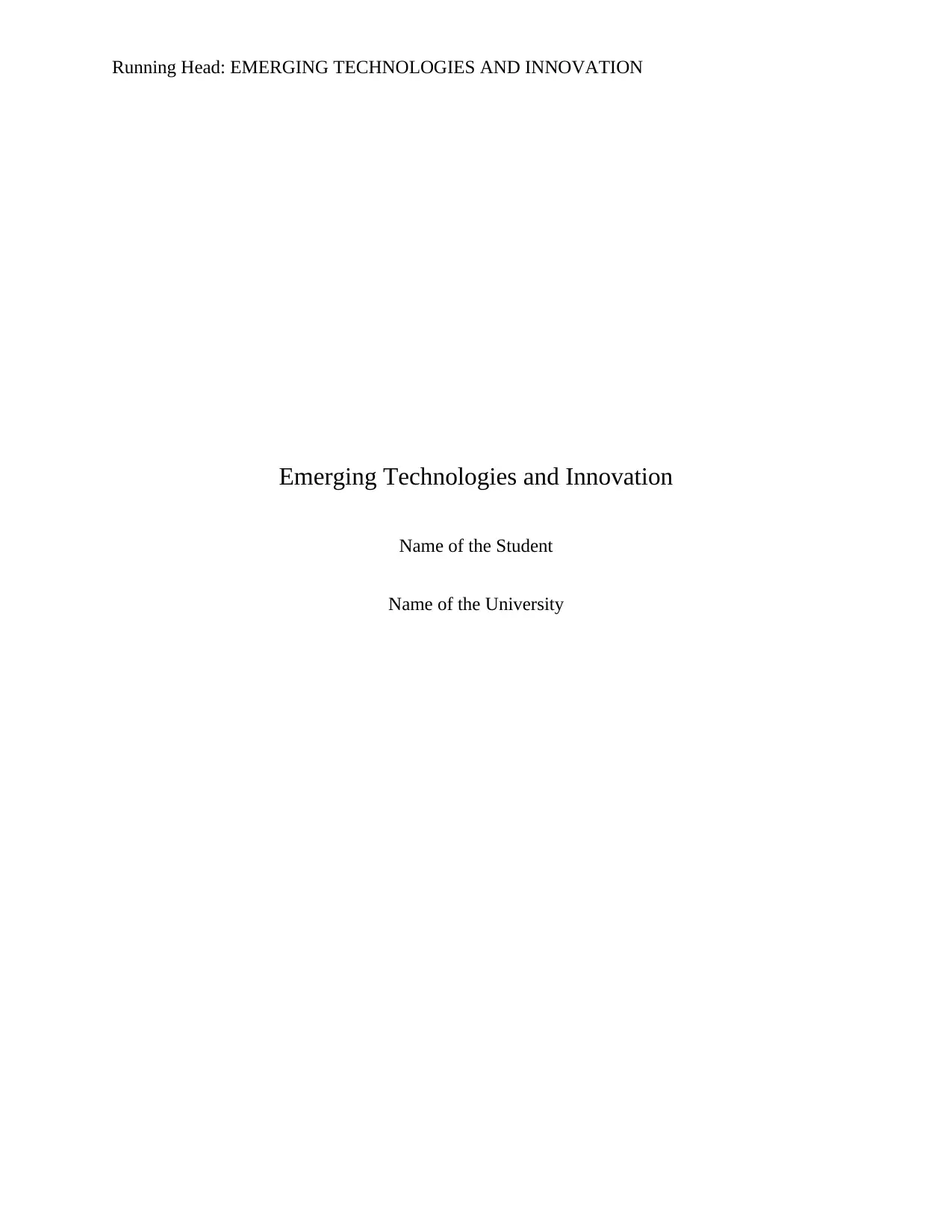
Running Head: EMERGING TECHNOLOGIES AND INNOVATION
Emerging Technologies and Innovation
Name of the Student
Name of the University
Emerging Technologies and Innovation
Name of the Student
Name of the University
Paraphrase This Document
Need a fresh take? Get an instant paraphrase of this document with our AI Paraphraser
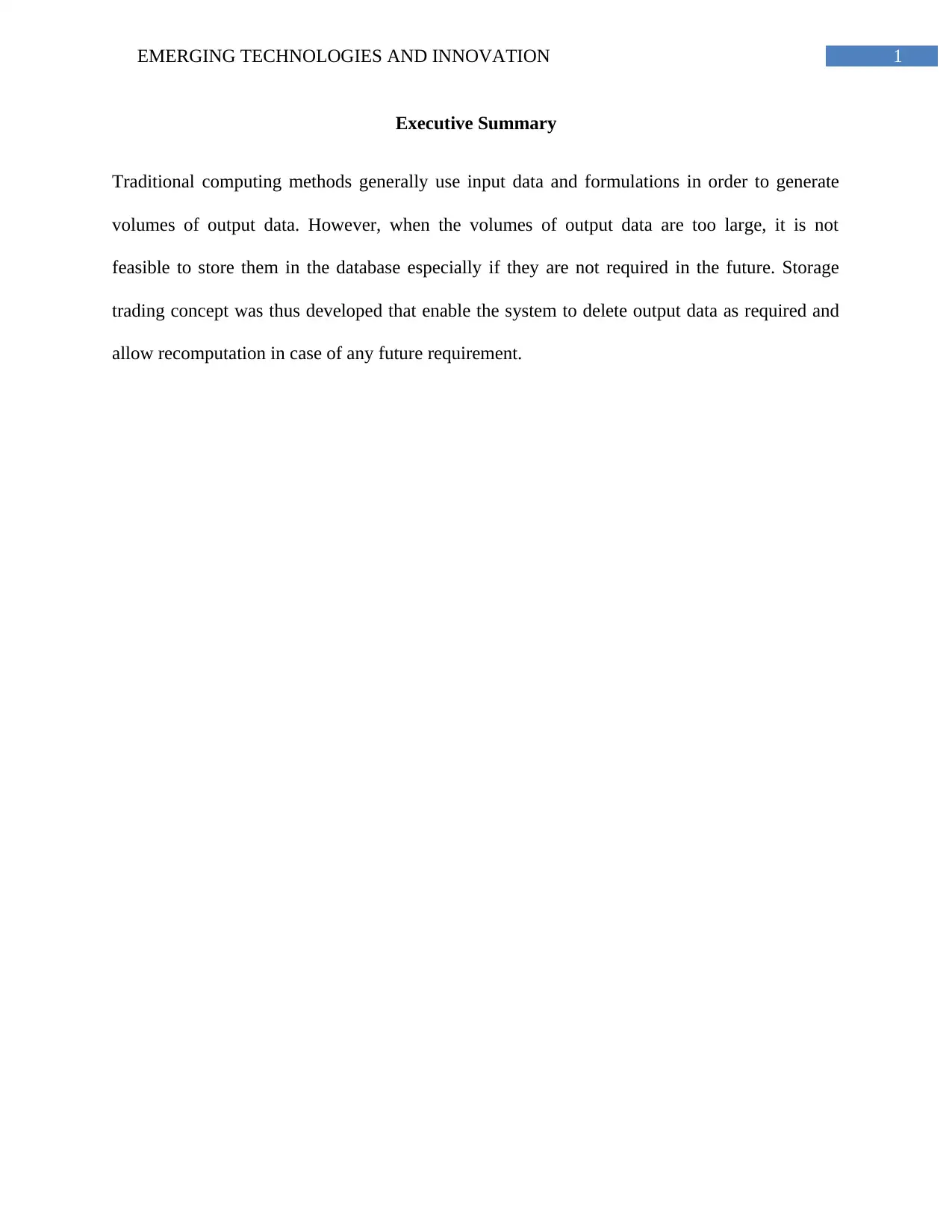
1EMERGING TECHNOLOGIES AND INNOVATION
Executive Summary
Traditional computing methods generally use input data and formulations in order to generate
volumes of output data. However, when the volumes of output data are too large, it is not
feasible to store them in the database especially if they are not required in the future. Storage
trading concept was thus developed that enable the system to delete output data as required and
allow recomputation in case of any future requirement.
Executive Summary
Traditional computing methods generally use input data and formulations in order to generate
volumes of output data. However, when the volumes of output data are too large, it is not
feasible to store them in the database especially if they are not required in the future. Storage
trading concept was thus developed that enable the system to delete output data as required and
allow recomputation in case of any future requirement.
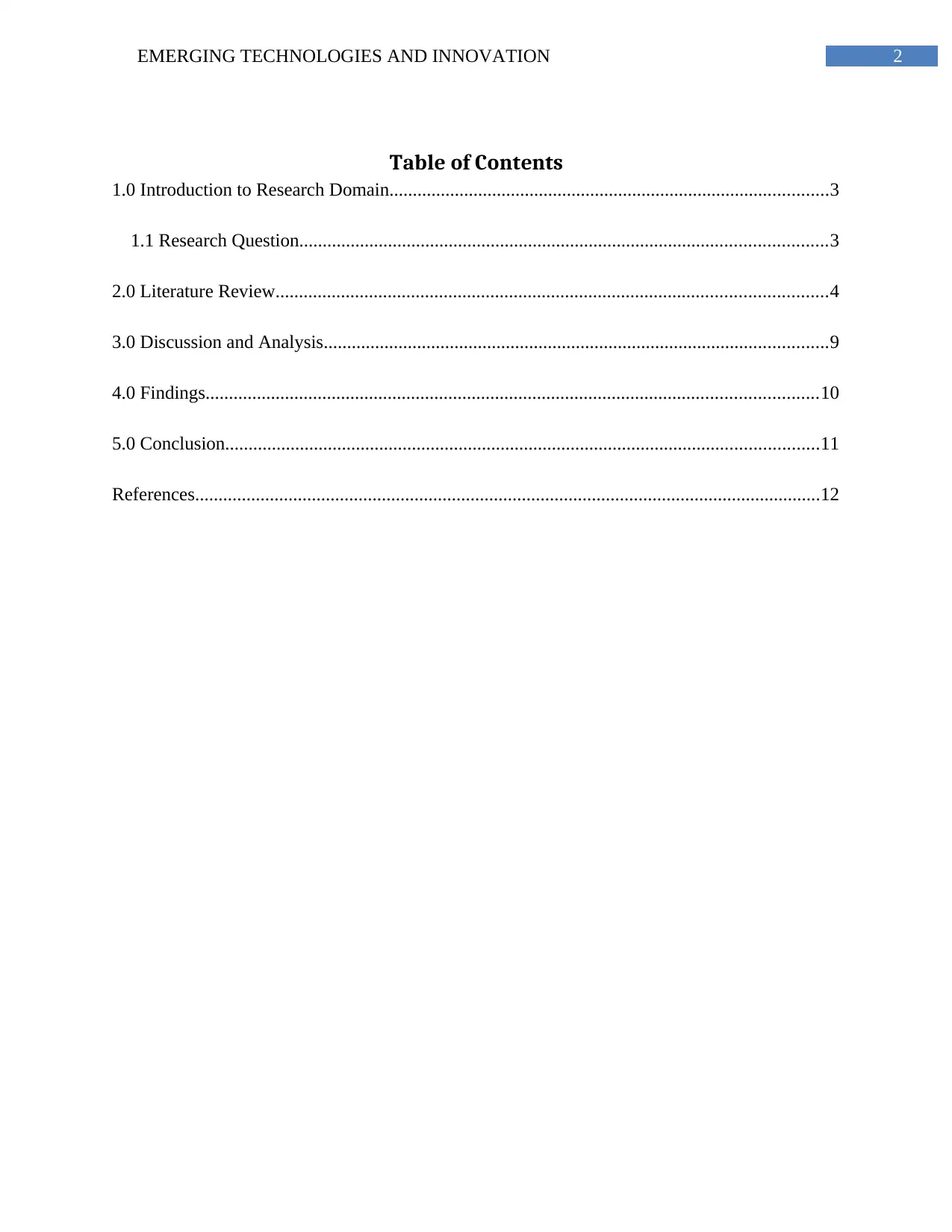
2EMERGING TECHNOLOGIES AND INNOVATION
Table of Contents
1.0 Introduction to Research Domain..............................................................................................3
1.1 Research Question.................................................................................................................3
2.0 Literature Review......................................................................................................................4
3.0 Discussion and Analysis............................................................................................................9
4.0 Findings...................................................................................................................................10
5.0 Conclusion...............................................................................................................................11
References......................................................................................................................................12
Table of Contents
1.0 Introduction to Research Domain..............................................................................................3
1.1 Research Question.................................................................................................................3
2.0 Literature Review......................................................................................................................4
3.0 Discussion and Analysis............................................................................................................9
4.0 Findings...................................................................................................................................10
5.0 Conclusion...............................................................................................................................11
References......................................................................................................................................12
⊘ This is a preview!⊘
Do you want full access?
Subscribe today to unlock all pages.

Trusted by 1+ million students worldwide
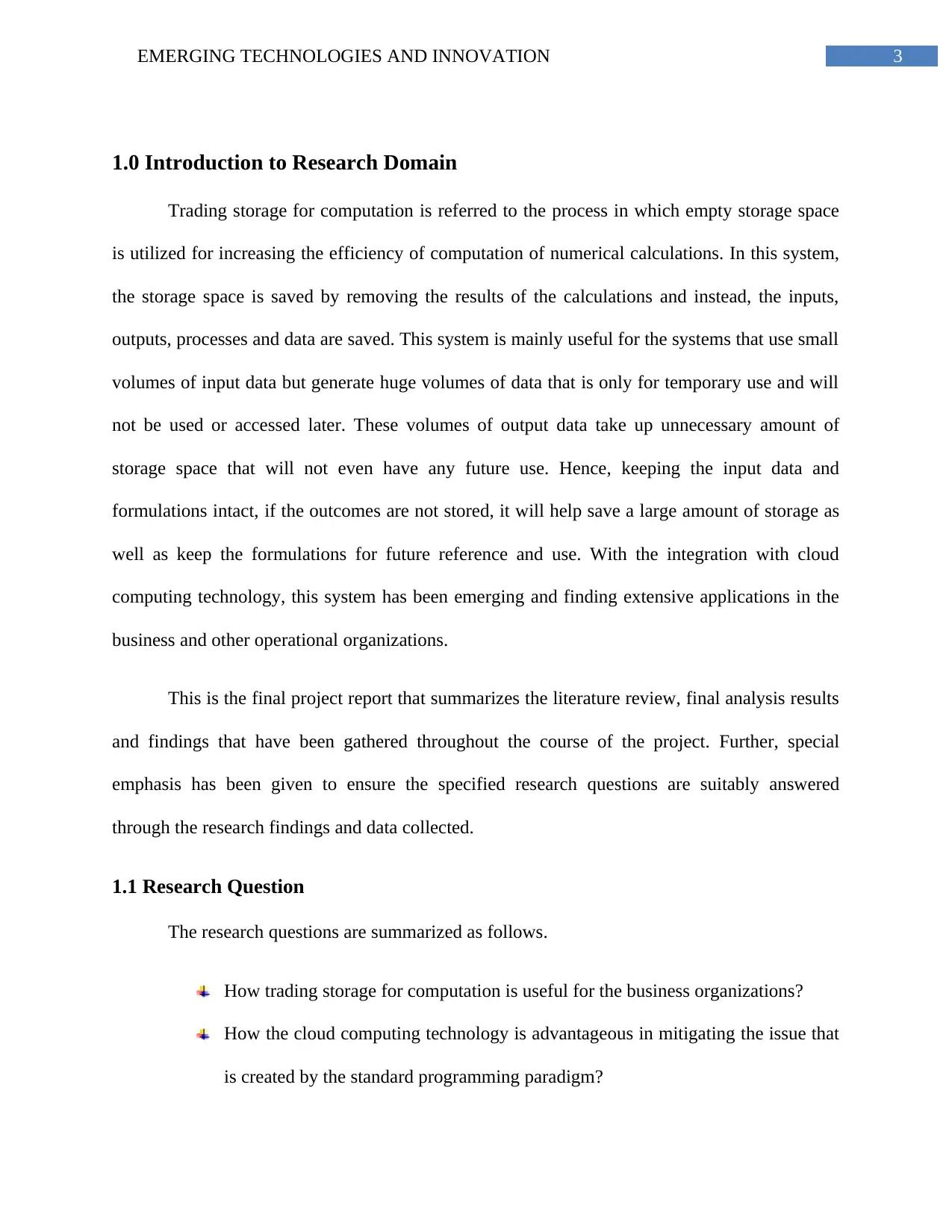
3EMERGING TECHNOLOGIES AND INNOVATION
1.0 Introduction to Research Domain
Trading storage for computation is referred to the process in which empty storage space
is utilized for increasing the efficiency of computation of numerical calculations. In this system,
the storage space is saved by removing the results of the calculations and instead, the inputs,
outputs, processes and data are saved. This system is mainly useful for the systems that use small
volumes of input data but generate huge volumes of data that is only for temporary use and will
not be used or accessed later. These volumes of output data take up unnecessary amount of
storage space that will not even have any future use. Hence, keeping the input data and
formulations intact, if the outcomes are not stored, it will help save a large amount of storage as
well as keep the formulations for future reference and use. With the integration with cloud
computing technology, this system has been emerging and finding extensive applications in the
business and other operational organizations.
This is the final project report that summarizes the literature review, final analysis results
and findings that have been gathered throughout the course of the project. Further, special
emphasis has been given to ensure the specified research questions are suitably answered
through the research findings and data collected.
1.1 Research Question
The research questions are summarized as follows.
How trading storage for computation is useful for the business organizations?
How the cloud computing technology is advantageous in mitigating the issue that
is created by the standard programming paradigm?
1.0 Introduction to Research Domain
Trading storage for computation is referred to the process in which empty storage space
is utilized for increasing the efficiency of computation of numerical calculations. In this system,
the storage space is saved by removing the results of the calculations and instead, the inputs,
outputs, processes and data are saved. This system is mainly useful for the systems that use small
volumes of input data but generate huge volumes of data that is only for temporary use and will
not be used or accessed later. These volumes of output data take up unnecessary amount of
storage space that will not even have any future use. Hence, keeping the input data and
formulations intact, if the outcomes are not stored, it will help save a large amount of storage as
well as keep the formulations for future reference and use. With the integration with cloud
computing technology, this system has been emerging and finding extensive applications in the
business and other operational organizations.
This is the final project report that summarizes the literature review, final analysis results
and findings that have been gathered throughout the course of the project. Further, special
emphasis has been given to ensure the specified research questions are suitably answered
through the research findings and data collected.
1.1 Research Question
The research questions are summarized as follows.
How trading storage for computation is useful for the business organizations?
How the cloud computing technology is advantageous in mitigating the issue that
is created by the standard programming paradigm?
Paraphrase This Document
Need a fresh take? Get an instant paraphrase of this document with our AI Paraphraser

4EMERGING TECHNOLOGIES AND INNOVATION
What are steps that are required to be followed by the business organizations for
developing trading storage for computation?
2.0 Literature Review
According to Joshi, Liu and Soljanin (2014), the combination of cloud computing and
tradeoff storage has been benefitting trans coding in real life scenario as well as video layer
encoding and decoding. The authors based their work on wireless technologies like WCDMA
and LTE and set out to evaluate the requirements for implementing trade off technology for
efficient and effective computation purposes.
As per McEvoy and Correll (2015), the trading storage for computing process has been
significantly benefitted by the integration with cloud computing because cloud computing is an
easily accessible technology with very less complexity. They have reported that the cloud
computing holistic view is essentially useful for selecting the specific results that is to be stored
for future accessibility and removing every other results that will lose relevance after some time.
Chen (2015) said that in addition to saving significant amount of storage space and
increasing computing efficiency, the storage trade off system also helps in cutting costs and time
during operations and processing of data. The efficiency of computation significantly increases
with the implementation of trading storage for computation.
Zhao et al. (2015) developed certain programming paradigms in order to manage the
storage trade off process such that it follows a particular framework for calculation, storage and
retrieval of data. However, they also reported that finding the balance between storage and
computation is extremely difficult even through the storage is traded off with the computing
What are steps that are required to be followed by the business organizations for
developing trading storage for computation?
2.0 Literature Review
According to Joshi, Liu and Soljanin (2014), the combination of cloud computing and
tradeoff storage has been benefitting trans coding in real life scenario as well as video layer
encoding and decoding. The authors based their work on wireless technologies like WCDMA
and LTE and set out to evaluate the requirements for implementing trade off technology for
efficient and effective computation purposes.
As per McEvoy and Correll (2015), the trading storage for computing process has been
significantly benefitted by the integration with cloud computing because cloud computing is an
easily accessible technology with very less complexity. They have reported that the cloud
computing holistic view is essentially useful for selecting the specific results that is to be stored
for future accessibility and removing every other results that will lose relevance after some time.
Chen (2015) said that in addition to saving significant amount of storage space and
increasing computing efficiency, the storage trade off system also helps in cutting costs and time
during operations and processing of data. The efficiency of computation significantly increases
with the implementation of trading storage for computation.
Zhao et al. (2015) developed certain programming paradigms in order to manage the
storage trade off process such that it follows a particular framework for calculation, storage and
retrieval of data. However, they also reported that finding the balance between storage and
computation is extremely difficult even through the storage is traded off with the computing

5EMERGING TECHNOLOGIES AND INNOVATION
processes. The authors have also identified that standard programming paradigm for storing of
data results in the formation of numerous challenges and issues in spite of the benefits received
from the system.
Authors like Sasidharan, Senthoor and Kumar (2014) developed conceptual frameworks
of the storage trading for computation that have been published in their papers. They reported
that when a simple model is implemented, the final computation state is stored and during access
for further reference, the results are directly read from the final computation state itself.
Authors Liu et al. (2014) also added recomputation process that utilizes cloud
architecture and is used within the holistic model of computing. They said that the cloud
infrastructure is utilized to perform the recomputation process that is much more effective and
less time consuming. Furthermore, the authors have used some storage algorithms that they
implemented in python. A part of the storage algorithm developed by the authors is shown as
follows.
“
" Storage_Algorithm.py: uses DAG_Reader.py to parse the sample xml file containing a
DAG and returns the cost of store-all and the storage and re-computation costs of the nodes
selected by the storage algorithm
"""
from DAG_Reader import DAGParser
DAG_FILE="dag2.xml"
processes. The authors have also identified that standard programming paradigm for storing of
data results in the formation of numerous challenges and issues in spite of the benefits received
from the system.
Authors like Sasidharan, Senthoor and Kumar (2014) developed conceptual frameworks
of the storage trading for computation that have been published in their papers. They reported
that when a simple model is implemented, the final computation state is stored and during access
for further reference, the results are directly read from the final computation state itself.
Authors Liu et al. (2014) also added recomputation process that utilizes cloud
architecture and is used within the holistic model of computing. They said that the cloud
infrastructure is utilized to perform the recomputation process that is much more effective and
less time consuming. Furthermore, the authors have used some storage algorithms that they
implemented in python. A part of the storage algorithm developed by the authors is shown as
follows.
“
" Storage_Algorithm.py: uses DAG_Reader.py to parse the sample xml file containing a
DAG and returns the cost of store-all and the storage and re-computation costs of the nodes
selected by the storage algorithm
"""
from DAG_Reader import DAGParser
DAG_FILE="dag2.xml"
⊘ This is a preview!⊘
Do you want full access?
Subscribe today to unlock all pages.

Trusted by 1+ million students worldwide

6EMERGING TECHNOLOGIES AND INNOVATION
# storage/re-computation costs from Amazon Cloud computation_cost = .085
io_cost = .12 storage_cost = .1
# formula to calculate storage costs
def calc_storage(storage, store_cost, io_cost):
total_storage_cost = (storage * io_cost) + (storage * store_cost)
return total_storage_cost
# formula to calculate re-computation costs
def calc_recomp(storage, reuse, store_cost, io_cost, comp_cost, comp_time): recomp_cost =
reuse * ((storage * io_cost) + (comp_time * comp_cost)) return recomp_cost
# create DAGParser object dagGraph = DAGParser(DAG_FILE)
# find the storage cost for 'store-all' print 'calculating costs for store-all\n' total_scost = 0
for ID in dagGraph.DAG:
node = dagGraph.DAG[ID]
storage = float(node['storage'])
scost_per_node = calc_storage(storage, storage_cost, io_cost)
total_scost = total_scost + scost_per_node
print 'node ID: ', ID, 'node storage cost: ', scost_per_node
print 'store-all total storage cost (in $): ', total_scost, '\n'
# storage algorithm:
# storage/re-computation costs from Amazon Cloud computation_cost = .085
io_cost = .12 storage_cost = .1
# formula to calculate storage costs
def calc_storage(storage, store_cost, io_cost):
total_storage_cost = (storage * io_cost) + (storage * store_cost)
return total_storage_cost
# formula to calculate re-computation costs
def calc_recomp(storage, reuse, store_cost, io_cost, comp_cost, comp_time): recomp_cost =
reuse * ((storage * io_cost) + (comp_time * comp_cost)) return recomp_cost
# create DAGParser object dagGraph = DAGParser(DAG_FILE)
# find the storage cost for 'store-all' print 'calculating costs for store-all\n' total_scost = 0
for ID in dagGraph.DAG:
node = dagGraph.DAG[ID]
storage = float(node['storage'])
scost_per_node = calc_storage(storage, storage_cost, io_cost)
total_scost = total_scost + scost_per_node
print 'node ID: ', ID, 'node storage cost: ', scost_per_node
print 'store-all total storage cost (in $): ', total_scost, '\n'
# storage algorithm:
Paraphrase This Document
Need a fresh take? Get an instant paraphrase of this document with our AI Paraphraser

7EMERGING TECHNOLOGIES AND INNOVATION
"determines the cost of storage and the cost of re-computation
for all nodes in the DAG and stores based on the following
procedure:
if node re-computation cost > node storage cost ---> STORE
if node re-computation cost < node storage cost ---> RE-COMPUTE (or NOT STORE)
"""
print 'calculating costs for storage algorithm\n'
total_rcost = 0
total_scost = 0
for ID in dagGraph.DAG:
node = dagGraph.DAG[ID]
reuse = float(node['reuse'])
storage = float(node['storage'])
comp_time = float(node['compUnits']) / float(node['compPower'])
node_scost = calc_storage(storage, storage_cost, io_cost)
node_rcost = calc_recomp(storage, reuse,
storage_cost, io_cost, computation_cost,
comp_time)
print 'node ID: ', ID, 'node recomp cost: ', node_rcost
if node_scost > node_rcost and int(ID) != 1:
# node should NOT be stored, so add node_rcost to total_rcost
print 'node ID: ', ID, 'node storage cost: ', node_scost, '---> NOT
STORED\n' total_rcost = total_rcost + node_rcost
else:
print 'node ID: ', ID, 'node storage cost: ', node_scost, '--->
STORED\n' total_scost = total_scost + node_scost
print 'storage algorithm total re-computation cost (in $): ', total_rcost
print 'storage algorithm total storage cost (in $): ', total_scost
print 'storage algorithm total cost (in $): ', total_scost + total_rcost
”
Xue et al. (2016) also implemented algorithms for calculating storage costs during
recomputation process using case example as shown below.
“
"determines the cost of storage and the cost of re-computation
for all nodes in the DAG and stores based on the following
procedure:
if node re-computation cost > node storage cost ---> STORE
if node re-computation cost < node storage cost ---> RE-COMPUTE (or NOT STORE)
"""
print 'calculating costs for storage algorithm\n'
total_rcost = 0
total_scost = 0
for ID in dagGraph.DAG:
node = dagGraph.DAG[ID]
reuse = float(node['reuse'])
storage = float(node['storage'])
comp_time = float(node['compUnits']) / float(node['compPower'])
node_scost = calc_storage(storage, storage_cost, io_cost)
node_rcost = calc_recomp(storage, reuse,
storage_cost, io_cost, computation_cost,
comp_time)
print 'node ID: ', ID, 'node recomp cost: ', node_rcost
if node_scost > node_rcost and int(ID) != 1:
# node should NOT be stored, so add node_rcost to total_rcost
print 'node ID: ', ID, 'node storage cost: ', node_scost, '---> NOT
STORED\n' total_rcost = total_rcost + node_rcost
else:
print 'node ID: ', ID, 'node storage cost: ', node_scost, '--->
STORED\n' total_scost = total_scost + node_scost
print 'storage algorithm total re-computation cost (in $): ', total_rcost
print 'storage algorithm total storage cost (in $): ', total_scost
print 'storage algorithm total cost (in $): ', total_scost + total_rcost
”
Xue et al. (2016) also implemented algorithms for calculating storage costs during
recomputation process using case example as shown below.
“
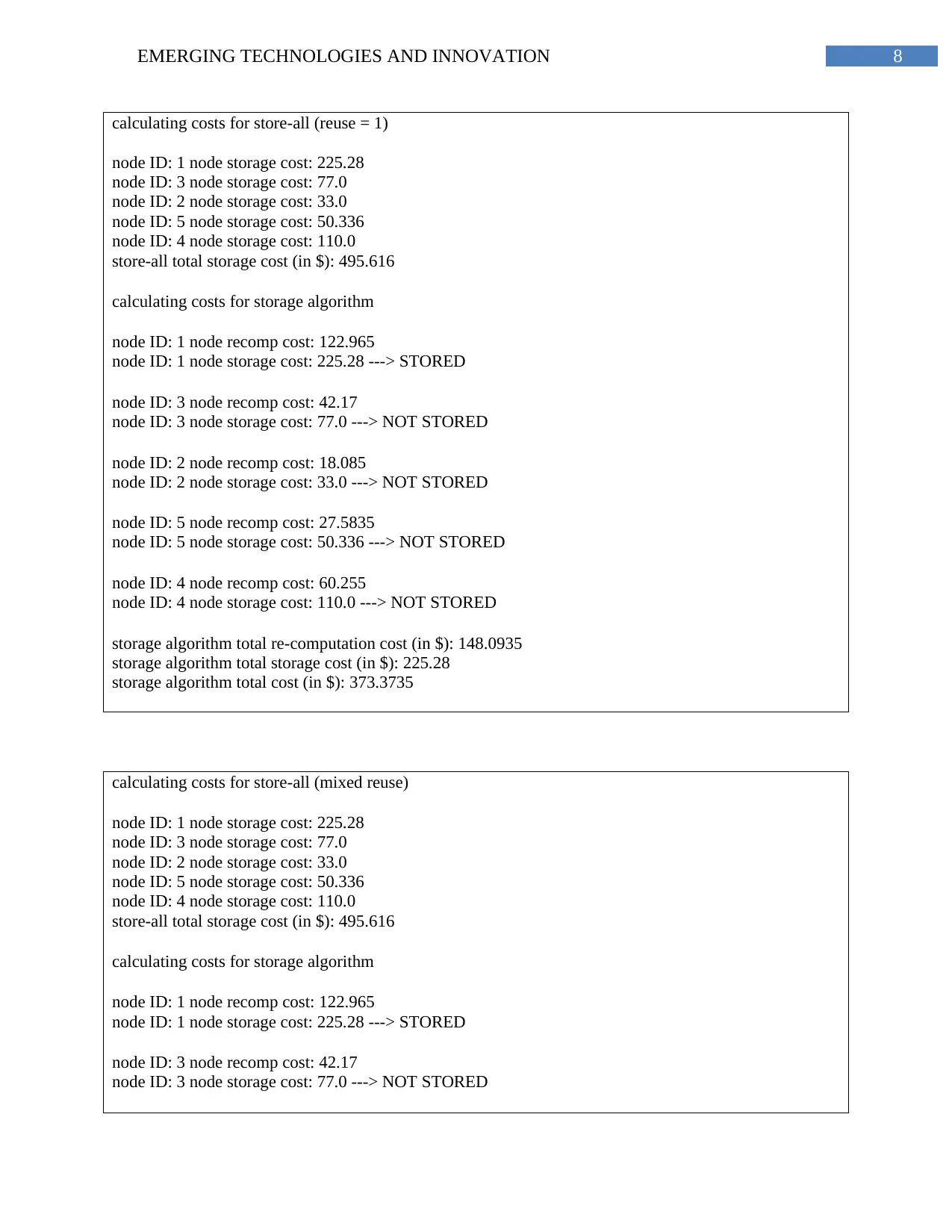
8EMERGING TECHNOLOGIES AND INNOVATION
calculating costs for store-all (reuse = 1)
node ID: 1 node storage cost: 225.28
node ID: 3 node storage cost: 77.0
node ID: 2 node storage cost: 33.0
node ID: 5 node storage cost: 50.336
node ID: 4 node storage cost: 110.0
store-all total storage cost (in $): 495.616
calculating costs for storage algorithm
node ID: 1 node recomp cost: 122.965
node ID: 1 node storage cost: 225.28 ---> STORED
node ID: 3 node recomp cost: 42.17
node ID: 3 node storage cost: 77.0 ---> NOT STORED
node ID: 2 node recomp cost: 18.085
node ID: 2 node storage cost: 33.0 ---> NOT STORED
node ID: 5 node recomp cost: 27.5835
node ID: 5 node storage cost: 50.336 ---> NOT STORED
node ID: 4 node recomp cost: 60.255
node ID: 4 node storage cost: 110.0 ---> NOT STORED
storage algorithm total re-computation cost (in $): 148.0935
storage algorithm total storage cost (in $): 225.28
storage algorithm total cost (in $): 373.3735
calculating costs for store-all (mixed reuse)
node ID: 1 node storage cost: 225.28
node ID: 3 node storage cost: 77.0
node ID: 2 node storage cost: 33.0
node ID: 5 node storage cost: 50.336
node ID: 4 node storage cost: 110.0
store-all total storage cost (in $): 495.616
calculating costs for storage algorithm
node ID: 1 node recomp cost: 122.965
node ID: 1 node storage cost: 225.28 ---> STORED
node ID: 3 node recomp cost: 42.17
node ID: 3 node storage cost: 77.0 ---> NOT STORED
calculating costs for store-all (reuse = 1)
node ID: 1 node storage cost: 225.28
node ID: 3 node storage cost: 77.0
node ID: 2 node storage cost: 33.0
node ID: 5 node storage cost: 50.336
node ID: 4 node storage cost: 110.0
store-all total storage cost (in $): 495.616
calculating costs for storage algorithm
node ID: 1 node recomp cost: 122.965
node ID: 1 node storage cost: 225.28 ---> STORED
node ID: 3 node recomp cost: 42.17
node ID: 3 node storage cost: 77.0 ---> NOT STORED
node ID: 2 node recomp cost: 18.085
node ID: 2 node storage cost: 33.0 ---> NOT STORED
node ID: 5 node recomp cost: 27.5835
node ID: 5 node storage cost: 50.336 ---> NOT STORED
node ID: 4 node recomp cost: 60.255
node ID: 4 node storage cost: 110.0 ---> NOT STORED
storage algorithm total re-computation cost (in $): 148.0935
storage algorithm total storage cost (in $): 225.28
storage algorithm total cost (in $): 373.3735
calculating costs for store-all (mixed reuse)
node ID: 1 node storage cost: 225.28
node ID: 3 node storage cost: 77.0
node ID: 2 node storage cost: 33.0
node ID: 5 node storage cost: 50.336
node ID: 4 node storage cost: 110.0
store-all total storage cost (in $): 495.616
calculating costs for storage algorithm
node ID: 1 node recomp cost: 122.965
node ID: 1 node storage cost: 225.28 ---> STORED
node ID: 3 node recomp cost: 42.17
node ID: 3 node storage cost: 77.0 ---> NOT STORED
⊘ This is a preview!⊘
Do you want full access?
Subscribe today to unlock all pages.

Trusted by 1+ million students worldwide
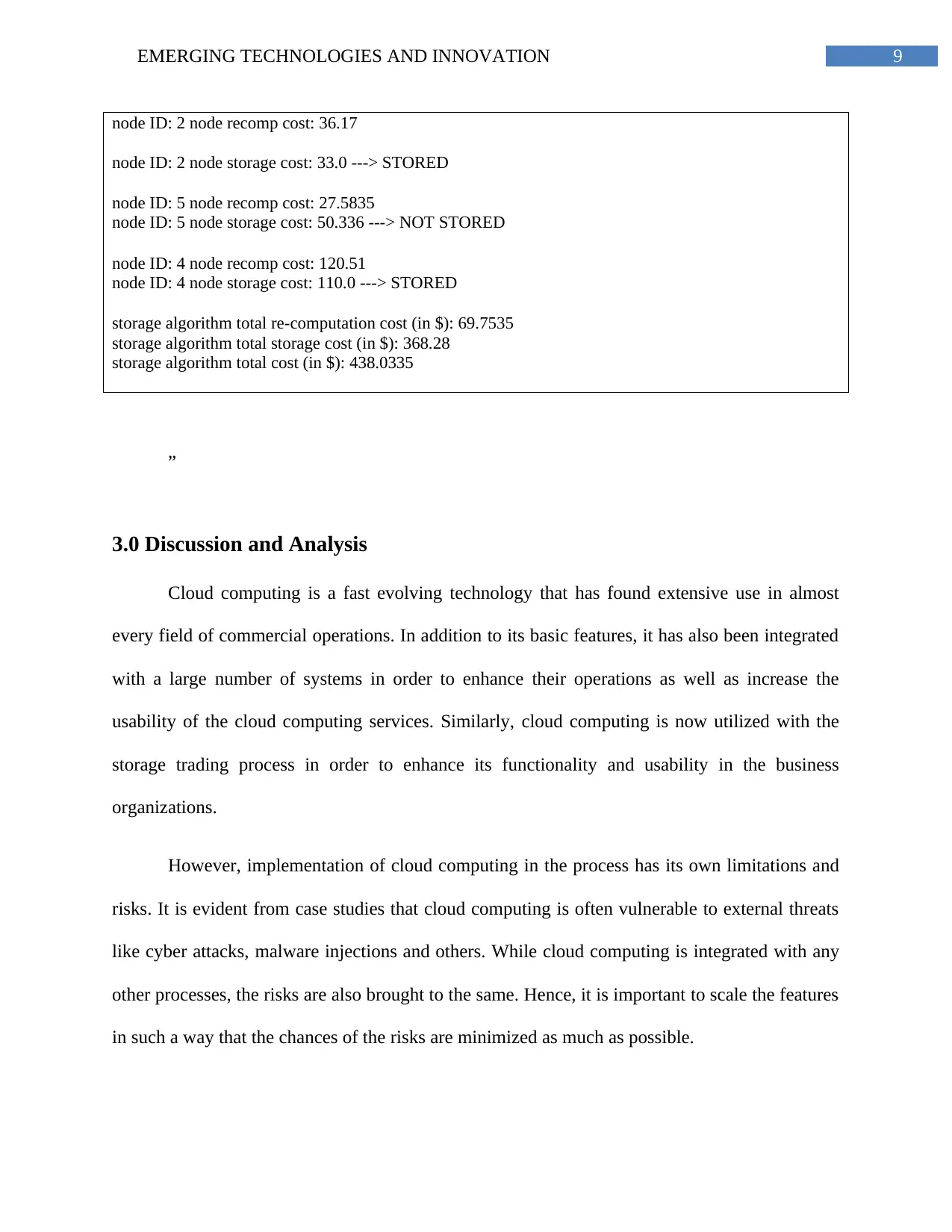
9EMERGING TECHNOLOGIES AND INNOVATION
node ID: 2 node recomp cost: 36.17
node ID: 2 node storage cost: 33.0 ---> STORED
node ID: 5 node recomp cost: 27.5835
node ID: 5 node storage cost: 50.336 ---> NOT STORED
node ID: 4 node recomp cost: 120.51
node ID: 4 node storage cost: 110.0 ---> STORED
storage algorithm total re-computation cost (in $): 69.7535
storage algorithm total storage cost (in $): 368.28
storage algorithm total cost (in $): 438.0335
”
3.0 Discussion and Analysis
Cloud computing is a fast evolving technology that has found extensive use in almost
every field of commercial operations. In addition to its basic features, it has also been integrated
with a large number of systems in order to enhance their operations as well as increase the
usability of the cloud computing services. Similarly, cloud computing is now utilized with the
storage trading process in order to enhance its functionality and usability in the business
organizations.
However, implementation of cloud computing in the process has its own limitations and
risks. It is evident from case studies that cloud computing is often vulnerable to external threats
like cyber attacks, malware injections and others. While cloud computing is integrated with any
other processes, the risks are also brought to the same. Hence, it is important to scale the features
in such a way that the chances of the risks are minimized as much as possible.
node ID: 2 node recomp cost: 36.17
node ID: 2 node storage cost: 33.0 ---> STORED
node ID: 5 node recomp cost: 27.5835
node ID: 5 node storage cost: 50.336 ---> NOT STORED
node ID: 4 node recomp cost: 120.51
node ID: 4 node storage cost: 110.0 ---> STORED
storage algorithm total re-computation cost (in $): 69.7535
storage algorithm total storage cost (in $): 368.28
storage algorithm total cost (in $): 438.0335
”
3.0 Discussion and Analysis
Cloud computing is a fast evolving technology that has found extensive use in almost
every field of commercial operations. In addition to its basic features, it has also been integrated
with a large number of systems in order to enhance their operations as well as increase the
usability of the cloud computing services. Similarly, cloud computing is now utilized with the
storage trading process in order to enhance its functionality and usability in the business
organizations.
However, implementation of cloud computing in the process has its own limitations and
risks. It is evident from case studies that cloud computing is often vulnerable to external threats
like cyber attacks, malware injections and others. While cloud computing is integrated with any
other processes, the risks are also brought to the same. Hence, it is important to scale the features
in such a way that the chances of the risks are minimized as much as possible.
Paraphrase This Document
Need a fresh take? Get an instant paraphrase of this document with our AI Paraphraser
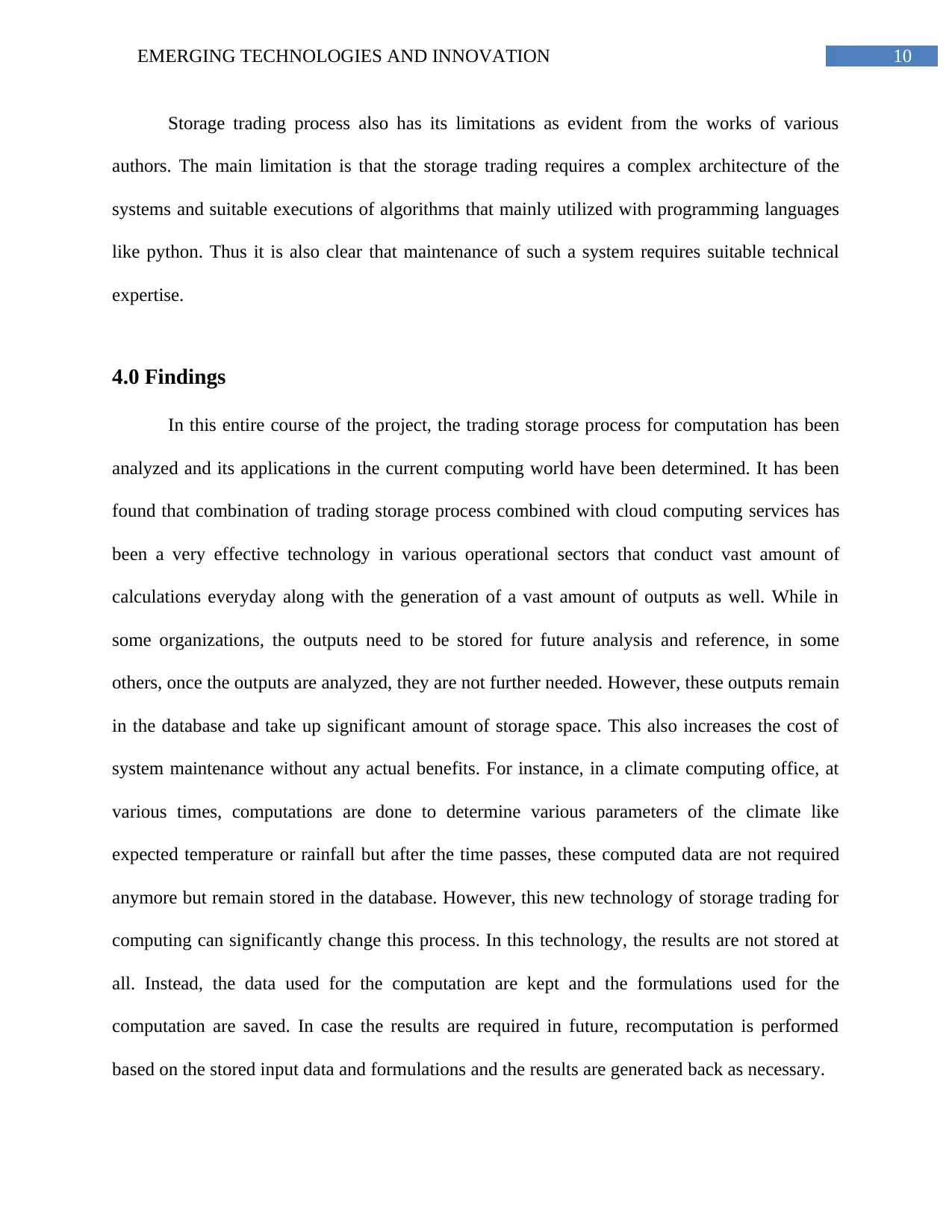
10EMERGING TECHNOLOGIES AND INNOVATION
Storage trading process also has its limitations as evident from the works of various
authors. The main limitation is that the storage trading requires a complex architecture of the
systems and suitable executions of algorithms that mainly utilized with programming languages
like python. Thus it is also clear that maintenance of such a system requires suitable technical
expertise.
4.0 Findings
In this entire course of the project, the trading storage process for computation has been
analyzed and its applications in the current computing world have been determined. It has been
found that combination of trading storage process combined with cloud computing services has
been a very effective technology in various operational sectors that conduct vast amount of
calculations everyday along with the generation of a vast amount of outputs as well. While in
some organizations, the outputs need to be stored for future analysis and reference, in some
others, once the outputs are analyzed, they are not further needed. However, these outputs remain
in the database and take up significant amount of storage space. This also increases the cost of
system maintenance without any actual benefits. For instance, in a climate computing office, at
various times, computations are done to determine various parameters of the climate like
expected temperature or rainfall but after the time passes, these computed data are not required
anymore but remain stored in the database. However, this new technology of storage trading for
computing can significantly change this process. In this technology, the results are not stored at
all. Instead, the data used for the computation are kept and the formulations used for the
computation are saved. In case the results are required in future, recomputation is performed
based on the stored input data and formulations and the results are generated back as necessary.
Storage trading process also has its limitations as evident from the works of various
authors. The main limitation is that the storage trading requires a complex architecture of the
systems and suitable executions of algorithms that mainly utilized with programming languages
like python. Thus it is also clear that maintenance of such a system requires suitable technical
expertise.
4.0 Findings
In this entire course of the project, the trading storage process for computation has been
analyzed and its applications in the current computing world have been determined. It has been
found that combination of trading storage process combined with cloud computing services has
been a very effective technology in various operational sectors that conduct vast amount of
calculations everyday along with the generation of a vast amount of outputs as well. While in
some organizations, the outputs need to be stored for future analysis and reference, in some
others, once the outputs are analyzed, they are not further needed. However, these outputs remain
in the database and take up significant amount of storage space. This also increases the cost of
system maintenance without any actual benefits. For instance, in a climate computing office, at
various times, computations are done to determine various parameters of the climate like
expected temperature or rainfall but after the time passes, these computed data are not required
anymore but remain stored in the database. However, this new technology of storage trading for
computing can significantly change this process. In this technology, the results are not stored at
all. Instead, the data used for the computation are kept and the formulations used for the
computation are saved. In case the results are required in future, recomputation is performed
based on the stored input data and formulations and the results are generated back as necessary.
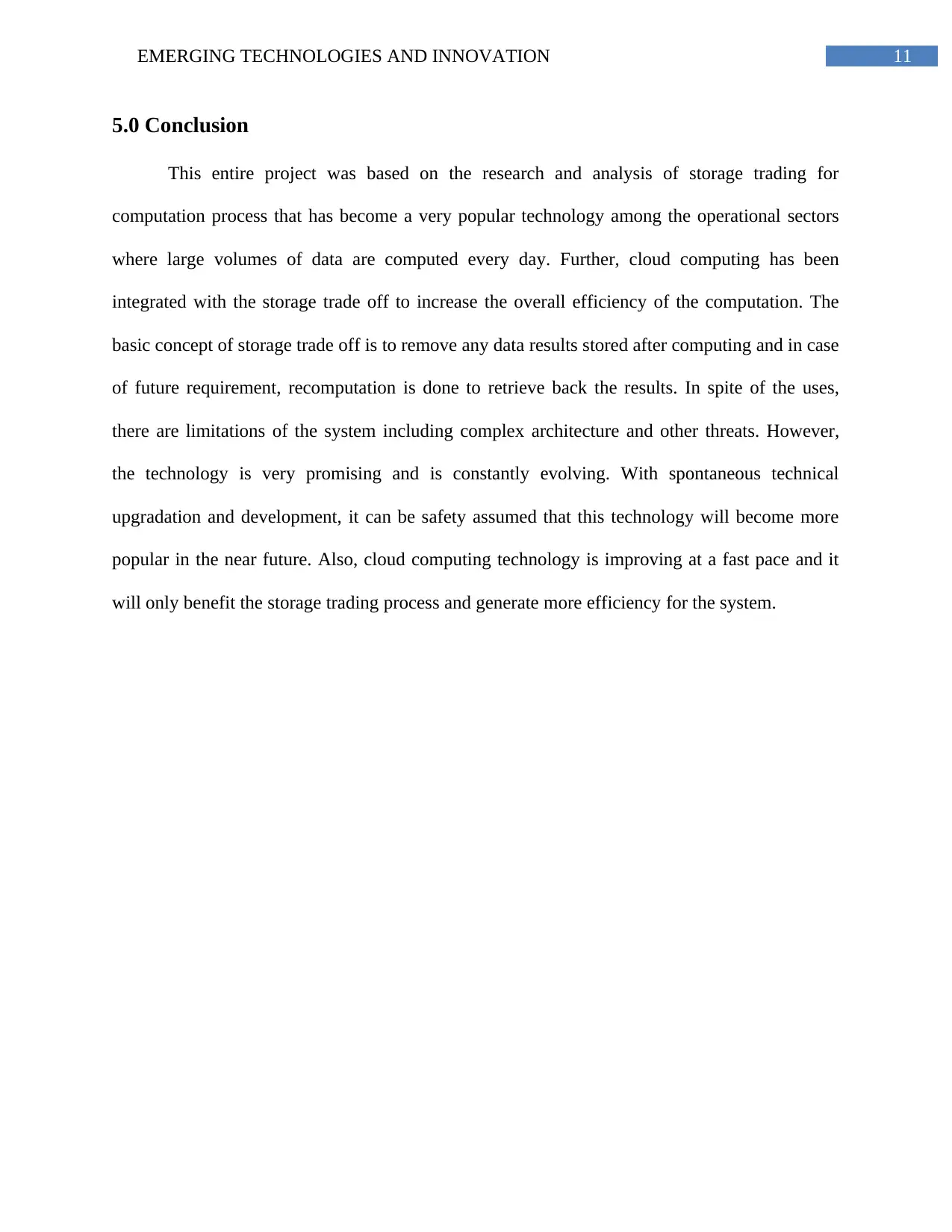
11EMERGING TECHNOLOGIES AND INNOVATION
5.0 Conclusion
This entire project was based on the research and analysis of storage trading for
computation process that has become a very popular technology among the operational sectors
where large volumes of data are computed every day. Further, cloud computing has been
integrated with the storage trade off to increase the overall efficiency of the computation. The
basic concept of storage trade off is to remove any data results stored after computing and in case
of future requirement, recomputation is done to retrieve back the results. In spite of the uses,
there are limitations of the system including complex architecture and other threats. However,
the technology is very promising and is constantly evolving. With spontaneous technical
upgradation and development, it can be safety assumed that this technology will become more
popular in the near future. Also, cloud computing technology is improving at a fast pace and it
will only benefit the storage trading process and generate more efficiency for the system.
5.0 Conclusion
This entire project was based on the research and analysis of storage trading for
computation process that has become a very popular technology among the operational sectors
where large volumes of data are computed every day. Further, cloud computing has been
integrated with the storage trade off to increase the overall efficiency of the computation. The
basic concept of storage trade off is to remove any data results stored after computing and in case
of future requirement, recomputation is done to retrieve back the results. In spite of the uses,
there are limitations of the system including complex architecture and other threats. However,
the technology is very promising and is constantly evolving. With spontaneous technical
upgradation and development, it can be safety assumed that this technology will become more
popular in the near future. Also, cloud computing technology is improving at a fast pace and it
will only benefit the storage trading process and generate more efficiency for the system.
⊘ This is a preview!⊘
Do you want full access?
Subscribe today to unlock all pages.

Trusted by 1+ million students worldwide
1 out of 14
Related Documents
Your All-in-One AI-Powered Toolkit for Academic Success.
+13062052269
info@desklib.com
Available 24*7 on WhatsApp / Email
![[object Object]](/_next/static/media/star-bottom.7253800d.svg)
Unlock your academic potential
Copyright © 2020–2025 A2Z Services. All Rights Reserved. Developed and managed by ZUCOL.




